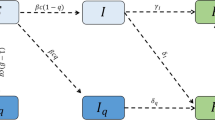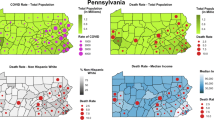Abstract
In sub-Saharan Africa, the model of care for people who are living with HIV/AIDS has changed from hospital care to home-based care. In this paper, a mathematical model describing the dynamics of HIV transmission, hospitalization, and home-based care is constructed and analysed. The model reproduction number R e is determined and discussed. The equilibria are determined and analysed in terms of R e . It is shown that if R e <1, the disease free equilibrium is both locally and globally asymptotically stable. The model has a unique endemic equilibrium and is locally asymptotically stable whenever R e >1. Five cases arise in the discussion of R e pertaining to intervention strategies. Numerical simulations are done to compare the impact of each strategy on the dynamics of HIV/AIDS. The model is fitted to the prevalence data estimates from UNAIDS on Zimbabwe. The implications of some key epidemiological parameters are investigated numerically. Projections are made to determine the possible long term trends of the prevalence of HIV in Zimbabwe.
Similar content being viewed by others
References
Akintola, O. A gendered analysis of the burden of care on family and volunteer caregivers in Uganda and South Africa. www.heard.org.za.
Anderson, R. M., & May, R. M. (1991). Infectious diseases of humans. London: Oxford University Press.
WHO (2010). Antiretroviral therapy for HIV infection in adults and adolescents: recommendations for a public health approach. www.who.int, 2010 revision.
Bacaër, N., Ouifki, R., Pretorius, C., Wood, R., & Williams, B. (2007). Modelling the joint TB/HIV epidemic in a South African township. Math. Biol., 57, 557–593.
Blower, S. M., Gershengorn, H. B., & Grant, R. M. (2000). A tale of two futures: HIV and antiretroviral therapy in San Francisco. Science, 287.
Bowong, S., & Tewa, J. J. (2009) Mathematical analysis of a tuberculosis model with differential infectivity. Commun. Nonlinear Sci. Numer. Simul., 14, 4010–4021.
Carr, J. (1981). Applications centre manifold theory. New York: Springer.
Castillo-Chavez, C., & Song, B. (2004). Dynamical models of tuberculosis and their applications. Math. Biosci. Eng., 1, 361–404.
Coates, T. J., Morin, S. F., & McKusick, L. (1989). Behavioural consequences of AIDS antibody testing among gay men. JAMA, 258, 1889.
Coombs, R. W. et al. (1989). Plasma viremia in human immunodeficiency virus infection. N. Engl. J. Med., 321, 1626–1631.
Dougan, S., Evans, B. G., & Elford, J. (2007). Sexually transmitted infections in Western Europe among HIV positive men who have sex with men. Sex. Transm. Dis., 34, 783–790.
Guinness, L., & Alban, A. (2000). The economic impact of AIDS in Africa: a review of the literature, UNAIDS background paper for ADF 2000. AIDS: the greatest leadership challenge, Addis Ababa. www.unaids.org.
Hallet, T. M., Gregson, S., Mugurungi, O., Gonese, E., & Garnett, G. P. (2009) Assessing evidence for behaviour change affecting the course of HIV epidemics: a new mathematical modelling approach and application to data from Zimbabwe. Epidemics, 1, 108–117.
Hallett, T. B. et al. (2006). Declines in HIV prevalence can be associated with changing sexual behaviour in Uganda, urban Kenya, Zimbabwe, and urban Haiti. Sex. Transm. Infect., 82, 1–8.
Higgins, D. L., et al. (1991). Evidence of the effects of HIV antibody counselling and testing on risk behaviours. JAMA, 266, 2419–2429.
Ho, D. D., Moudgil, T., Alam, M. (1989). Quantitation of human immunodeficiency virus type I in the blood of infected persons. N. Engl. J. Med., 321, 1621–1625.
Hove-Musekwa, S. D., & Nyabadza, F. (2009). The dynamics of an HIV/AIDS model with screened disease carriers. CMMM, 10.
Hutson, V., & Schmitt, K., (1992). Permanence and the dynamics of biological systems. Math. Biosci., 111, 1–71
La Salle, J. P. (1976). CBMS-NSF regional conference series in applied mathematics: Vol. 25. The stability of dynamical systems. Philadelphia: SIAM.
Lungu, EM, Kgosimore, M., & Nyabadza, F. (2006). Models for the spread of HIV/AIDS: trends in Southern Africa. In A. B. Gumel et al. (Eds.), Mathematical studies on human disease dynamics: emerging paradigms and challenges. Providence: AMS (pp. 259–277).
Moghadas, M. S., Gumel, A. B., Mcleod, R. G., & Gordon, R. (2003). Could condoms stop the AIDS epidemic? J. Theor. Med., 5, 171–181.
Mugisha, J. Y. T., Baryarama, F., & Luboobi, L. S. (2006). Modelling HIV/AIDS with complacency in a population with declining prevalence. Comput. Math. Methods Med., 7, 27–35.
Mugurungi, O. et al. (2009). Report compiled and edited by the ANC HIV Estimates Technical Working Group Zimbabwe. www.ochaonline.un.org.
Mukandavire, Z., Garira, W., & Chiyaka, C. (2007). Asymptotic properties of an HIV/AIDS model with time delay. J. Math. Anal. Appl., 330, 916–933.
Musgrave, J., & Watmough, J. (2009). Examination of a simple model of condom usage and individual withdrawal for the HIV epidemic. Math. Biosci. Eng., 6, 363–376.
National Guideline on Home-Based Care and Community-Based Care, Department of Health, South Africa. http://www.capegateway.gov.za/Text/2003/define_homebased.pdf.
National home-based care programme and service guidelines (2002). National AIDS/STD Control Programme, Ministry of Health, Kenya.
Nyabadza, F. (2006). A mathematical model for combating HIV/AIDS in Southern Africa: will multiple strategies work? J. Biol Syst., 14, 357–372.
Nyabadza, F. (2008). On the complexity of modelling HIV/AIDS in Southern Africa. Math. Model. Anal., 13, 539–552.
Nyabadza, F., Chiyaka, C., & Mukandavire, Z. (2010). Analysis of an HIV/AIDS model with public-health information campaigns and individual withdrawal. J. Biol. Syst., 18, 357–375.
Osmond, D. H., Pollack, L. M., Paul, J. P., & Catania, J. A. (2007). Changes in prevalence of HIV infection and sexual risk behavior in men who have sex with men in San Francisco: 1997–2002. Am. J. Publ. Health, 97, 1677–1683.
Responding to HIV/AIDS, Community home-based care, fact sheet. www.pathfind.org.
Seventeen is the average age of first sex: American Sexual Behaviour. Available at http://www.newstrategist.com.
Shango, K. (2009). Zimbabwe HIV prevalence drops again to 11%. http://www.zimnetradio.com/news/zimnet27719.html.
Sharomi, O., & Gumel, A. B. (2008). Dynamical analysis of a multi-strain model of HIV in the presence of anti-retroviral drugs. J. Biol. Dyn., 2, 323–345.
Spire, B., de Zoysa, I., & Himmich, H. (2008). HIV prevention: What have we learned from community experiences in concentrated epidemics? J. Int. AIDS Soc., 11. doi:10.1186/1758-2652-11-5.
Tripathi, A., Naresh, R., & Sharma, D. (2007). Modelling the effect of screening of unaware infectives on the spread of HIV infection. Appl. Math. Comput., 184, 1053–1068.
UNAIDS (2008) Report on the global AIDS epidemic: www.unaids.org.
UNAIDS/WHO Epidemiological fact sheets on HIV and AIDS. www.unaids.org (2008, update).
United States Census Bureau International Database. http://www.census.gov/ipc/www/idb/country.php.
van den Driessche, P., & Watmough, J. (2002). Reproduction numbers and sub-threshold endemic equilibrium for compartmental models of disease transmission. Math. Biosci., 180, 29–48.
Vardavas, R., & Blower, S. (2007). The emergence of HIV transmitted resistance in Botswana: “when will the WHO detection threshold be exceeded?” PloS One. doi:10.1371/journal.pone.0000152.
Weinhardt, L. S., Carey, M. P., Johnson, B. T., & Bickham, N. L. (1999). Effects of HIV counseling and testing on sexual risk behavior: a meta-analytic review of published research, 1985–1997. Am. J. Publ. Health, 89, 1397–1405.
Zikhali, R. Zim HIV prevalence rate declines due to poverty: report. http://www.africanews.com.
Zimbabwe. http://www.afro.who.int/malaria/country-profile/zimbabwe.pdf.
Zungu-Dirwayi, N., Shisana, O., Udjo, E., Mosala, T., & Seager, J. (Eds.) (2004). An audit of HIV/AIDS policies in Botswana, Lesotho, Mozambique, South Africa, Swaziland and Zimbabwe. Cape Town: HSRC Press.
Author information
Authors and Affiliations
Corresponding author
Rights and permissions
About this article
Cite this article
Hove-Musekwa, S.D., Nyabadza, F. & Mambili-Mamboundou, H. Modelling Hospitalization, Home-Based Care, and Individual Withdrawal for People Living with HIV/AIDS in High Prevalence Settings. Bull Math Biol 73, 2888–2915 (2011). https://doi.org/10.1007/s11538-011-9651-7
Received:
Accepted:
Published:
Issue Date:
DOI: https://doi.org/10.1007/s11538-011-9651-7




